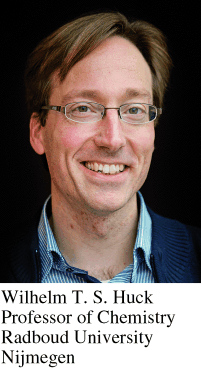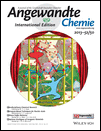Learning a New Language: Moving Countries and Changing Subjects
“Van de regen in de drup” was the title of my inaugural lecture at the Radboud University Nijmegen in March 2011. 1

The University of Cambridge is one of the premier academic institutions in the world. My transition to the Radboud University and the Dutch academic environment has been wonderfully smooth, as I was able to build up my new group in Nijmegen while retaining my group and research topics in Cambridge for as long as necessary. The Netherlands is a small country and the academic community is tight-knit, ambitious, and highly competitive. Within the Dutch system, you are in direct contact with many world-leading chemists, and this makes for a highly stimulating environment at all levels, from master’s students doing internships at various universities, to PhD students who come from all over the world, to scientific staff all trying to compete on a global stage.
“Out of the frying pan, into the fire” would not be a bad description if I look at the funding outlook for chemical sciences in the Netherlands. Although the chemical industry is (still) a major contributor to the economic health of the country, the lean economic times make it necessary to prioritize. It is therefore surprising that despite the stated ambition of the Netherlands to belong to the top five knowledge economies worldwide, the budget available to the Netherlands Organisation for Scientific Research (NWO) for basic chemistry research has actually suffered significant cuts. Chemistry makes important contributions to grand challenges in “energy”, “environment”, and “health” we are facing as a society. The Netherlands is following the UK and the USA in channeling major parts of the science budget into these areas. Compared to the UK, there is a much stronger emphasis on collaborative efforts between academic and industrial partners, and the research in these partnerships is strongly focused on large chemical companies. Although good science happens in these collaborations, the success rate at the NWO for other innovative areas of chemistry has dropped to dangerous levels. This is partly compensated by obtaining funding from European funding agencies such as the Seventh Framework Programme of the EU and the European Research Council, where the Netherlands is extraordinarily successful.
Why then should we talk about change? My postdoctoral advisor, George Whitesides, was a great advocate of change. He urged young scientists to work on important problems, even if they were very much outside the familiar environment of chemistry in which they were trained. I am still trying to put these lessons into practice! Chemists are masters in working outside the boundary of their own disciplines. The ability to synthesize new molecules of any size and shape, and our knowledge on how to control the interactions between molecules, has for decades been a main driver behind crucial new insights in physics, materials science, and biology. The spectacular progress in fields as far apart as pharmaceuticals, organic-polymer electronics, chemical and synthetic biology, batteries and solar fuels, and next-generation DNA sequencing serves as a testament of interdisciplinary research enabled by the tools of synthetic and analytical chemistry. However, our mastery of working across the boundaries of disciplines should encompass more than being a supplier of fine molecules to biologists, materials scientists, and physicists. We have a tremendous opportunity to broaden our discipline and study the very core fundamentals of biology.
Chemistry has transformed the world around us through our ability to synthesize molecules. Synthesis sets chemistry apart from physics and biology and has been at the core of what we think is chemistry. Of course, we can do more than synthesizing molecules. Supramolecular chemistry has moved the field “beyond the molecule”, by using the biological world as a source of inspiration to design and construct elaborate complexes held together by noncovalent interactions. The recent progress in DNA origami, where molecules are used as building blocks to build nanoscale structures, shows how much we have learned from biological structures. We have not only been inspired by biology. Both chemists and chemical biologists have delivered important new methods and molecules to biology, and it is becoming increasingly possible to use molecules to learn more about living cells or to alter the way they function.
However we should realize that biological systems do not at all resemble our chemical synthesis routes to complex molecules or self-assembled supramolecular systems. Living cells are characterized by complex networks of enzymes with thousands of synergistic and reciprocal relationships between many molecular components. Together, these reactions form the metabolism that sustains all essential processes such as gene expression and cell division. The cell is in a state of permanent flux of energy and building blocks. A living cell is far from equilibium. This is exactly where chemistry has not ventured. Our textbooks are full of reactions under thermodynamic control in which the same product is obtained regardless of the reaction pathway. Similarly, the self-assembled systems we study are at equilibrium and thus under thermodynamic control. We can bring chemical reactions under kinetic control, in which case the pathway followed matters greatly. Similarly, self-assembled systems under kinetic control will show different structures when different pathways are followed. Far-from-equilibrium systems can give rise to unique properties such as dissipative structures, oscillations, spatiotemporal patterns, and, ultimately, life.
The grand challenge for chemists is to develop the strategies to harness far-from-equilibrium systems. Eduard Buchner received the Nobel Prize in Chemistry in 1907 for his discovery of fermentation of sugar in cell-free extracts of yeast. It should thus be possible to construct these complex enzymatic networks in vitro. The design rules for metabolic and genetic networks have largely been established after decades of work by systems biologists and biophysicists. The rapidly developing field of synthetic biology is engineering the genetic code in such a way that the cell almost becomes a computer that reads off the new software encoded in DNA. What role can chemistry play? Despite our progress in synthesis, we are not remotely capable of constructing such a far-from-equilibrium system de novo. We do have a few starting points in inorganic chemistry, where perhaps the best-known example is the serendipitously discovered Belousov–Zabotinsky reaction. This reaction has been studied extensively and we have the mathematical tools to build out-of-equilibrium chemical networks. Now, we need to develop a new language of chemistry to translate the design rules into practice.
The ultimate goal of systems chemistry is to synthesize a cell. Reaching this goal would lead to a fundamental understanding of the way life functions and will shed light on the origin of life. A synthetic cell will also be a tool to track exactly how drug molecules alter different processes in a cell. Applications of systems chemistry will however not be confined to biology. As an example, we can start thinking about completely new types of smart materials with much broader abilities to adapt to their environment, by “computing” their best response.
What about the water droplets? The small water droplets I am interested in are cells. Although the interior of a typical bacterial cell contains some 60–70 % water, it is a highly crowded place in which macromolecules must compete for space in order to carry out their biological functions. As a chemical reactor, cells are completely unlike any reactor design used in chemistry. Crowding has significant consequences on the way macromolecules (proteins, DNA, RNA) interact with each other and changes their reactivity. To address the challenge of synthesizing a cell, it will be critical to rebuild the exact physical environment in which the complex cellular chemistry has to take place. So water droplets are the ideal reactors for discovering new chemistry.
In 1676, Dutch scientist Antonie van Leeuwenhoek wrote a letter to the Royal Society in London, in which he claimed that “In the year of 1675 I difcover’d living creatures in Rain water …︁”. This letter was initially received with great scepticism. Today, we know that the “animalcules” he discovered with his home-made microscope in a drop of water are bacteria and protozoa. In his days, single cell organisms were completely unknown, but his credibility was also questioned because van Leeuwenhoek was a draper with no formal training in science. Like van Leeuwenhoek, I am interested in small water droplets …︁ and like van Leeuwenhoek, I am entering a field where I had little formal training! Might this inspire many chemists!





